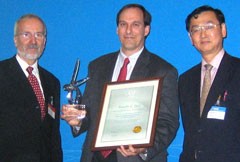ITER NEWSLINE
2
Nuclear Fusion Award winner announced
-
Nuclear Fusion Award winner announced
At the 21st IAEA Fusion Energy Conference in Chengdu, China, the lead author of a paper that demonstrates how one of the primary physics goals of ITER might be more safely realised was awarded the inaugural Nuclear Fusion Award, which is presented by the IAEA.

Winner of the inaugural Nuclear Fusion Award, Dr Timothy C. Luce (General Atomics), is presented with his award by Professor Werner Burkart (Deputy Director General, International Atomic Energy Agency) and Dr Mitsuru Kikuchi (Chairman of the Board of Editors, Nuclear Fusion and Director Division of Advanced Plasma Research, Japan Atomic Energy Agency) at the 21st IAEA fusion conference.
return to Newsline #2


